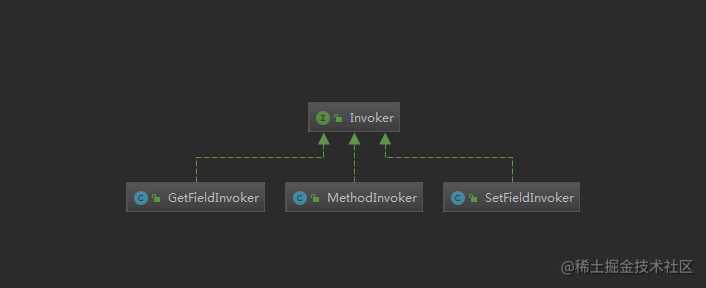基于Mybatis-3.5.0版本
1.0 Invoker执行器
org.apache.ibatis.reflection.invoker.Invoker执行器接口,这里主要是为了统一getter方法、setter方法和Field个get和set执行时的差异,使用了对象的适配器模式。代码和类图如下:

/**
* 执行器接口:为了统一getter方法、setter方法和Field的get和set执行时的差异
* 对象的适配器模式
* @author Clinton Begin
*/
public interface Invoker {
/**
* 执行调用
* 主要用于执行:getter方法、setter方法和Field的get和set
* @param target 目标
* @param args 参数
* @return 结果
* @throws IllegalAccessException
* @throws InvocationTargetException
*/
Object invoke(Object target, Object[] args) throws IllegalAccessException, InvocationTargetException;
/**
* @return 类
* 差异:
* 1.getter方法 返回返回类型
* 2.setter方法 返回参数类型
* 3.Field返回自身的类型
*/
Class<?> getType();
}
代码都比较简单,就直接上代码了
2.0 GetFieldInvoker
/** * Field get属性执行器 * @author Clinton Begin */
public class GetFieldInvoker implements Invoker {
//Field 对象 即被适配者
private final Field field;
public GetFieldInvoker(Field field) {
this.field = field;
}
/** * 获取 target Field的属性值 * 如果Field不可访问 (访问权限不够),则设置Accessible 强制访问 */
@Override
public Object invoke(Object target, Object[] args) throws IllegalAccessException {
try {
return field.get(target);
} catch (IllegalAccessException e) {
if (Reflector.canControlMemberAccessible()) {
field.setAccessible(true);
return field.get(target);
} else {
throw e;
}
}
}
/** * 返回Field类型 */
@Override
public Class<?> getType() {
return field.getType();
}
}
2.1 SetFieldInvoker
/** * Field set属性执行器 * @author Clinton Begin */
public class SetFieldInvoker implements Invoker {
// Field 对象 即被适配者
private final Field field;
public SetFieldInvoker(Field field) {
this.field = field;
}
/** * 设置 target Field的属性值 * 如果Field不可访问 (访问权限不够),则设置Accessible 强制访问 */
@Override
public Object invoke(Object target, Object[] args) throws IllegalAccessException {
try {
field.set(target, args[0]);
} catch (IllegalAccessException e) {
if (Reflector.canControlMemberAccessible()) {
field.setAccessible(true);
field.set(target, args[0]);
} else {
throw e;
}
}
return null;
}
/** * 返回Field类型 */
@Override
public Class<?> getType() {
return field.getType();
}
}
2.2 MethodInvoker
/** * getter或setter方法执行器 * @author Clinton Begin */
public class MethodInvoker implements Invoker {
/** * getter方法 返回返回类型 * setter方法 返回参数类型 */
private final Class<?> type;
/** * Method对象 即被适配者 */
private final Method method;
public MethodInvoker(Method method) {
this.method = method;
if (method.getParameterTypes().length == 1) {
type = method.getParameterTypes()[0];
} else {
type = method.getReturnType();
}
}
/** * 执行method对象对应的方法 * 如果method不可访问 (访问权限不够),则设置Accessible 强制访问 */
@Override
public Object invoke(Object target, Object[] args) throws IllegalAccessException, InvocationTargetException {
try {
return method.invoke(target, args);
} catch (IllegalAccessException e) {
if (Reflector.canControlMemberAccessible()) {
method.setAccessible(true);
return method.invoke(target, args);
} else {
throw e;
}
}
}
@Override
public Class<?> getType() {
return type;
}
}
3.0 适配器模式
适配器模式下面这篇文章介绍的还不错:
4.0 总结
大家在实际的开发中也可以巧用一些设计模式,使项目的代码更加健壮。例如Mybatis反射模块中,如果这里不使用适配器模式,那在Reflector中缓存setter和getter的元信息时就不得不使用4个Map分别缓存:getter方法,setter方法、Field-get和Field-set,并且在实际的使用时还要去做if判断
失控的阿甘,乐于分享,记录点滴
今天的文章Mybatis技术内幕(2.3.3):反射模块-Invoker分享到此就结束了,感谢您的阅读。
版权声明:本文内容由互联网用户自发贡献,该文观点仅代表作者本人。本站仅提供信息存储空间服务,不拥有所有权,不承担相关法律责任。如发现本站有涉嫌侵权/违法违规的内容, 请发送邮件至 举报,一经查实,本站将立刻删除。
如需转载请保留出处:https://bianchenghao.cn/14676.html
